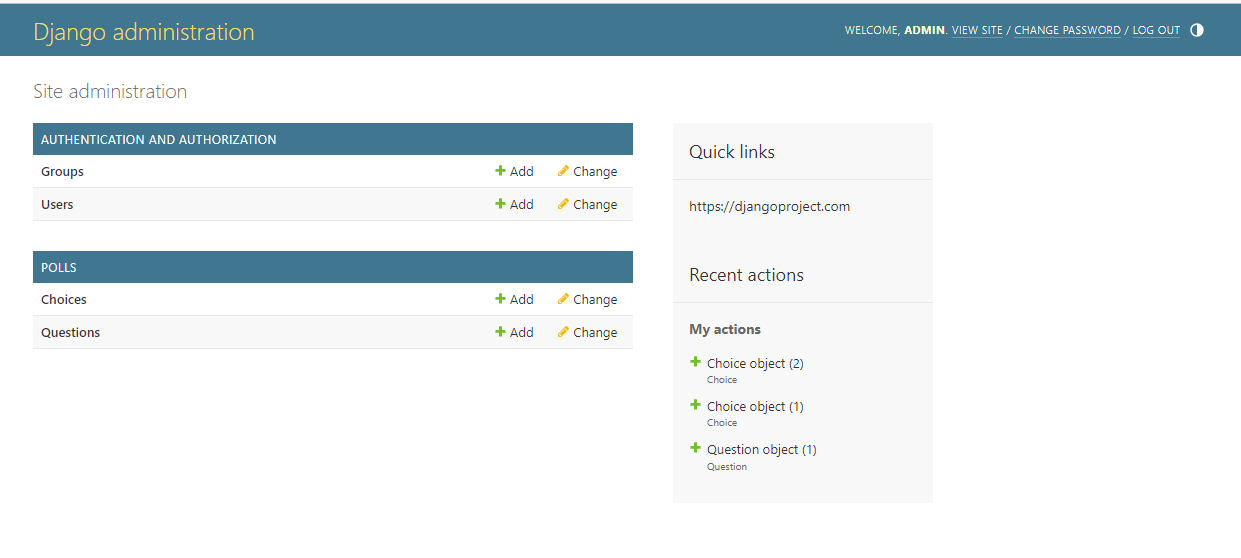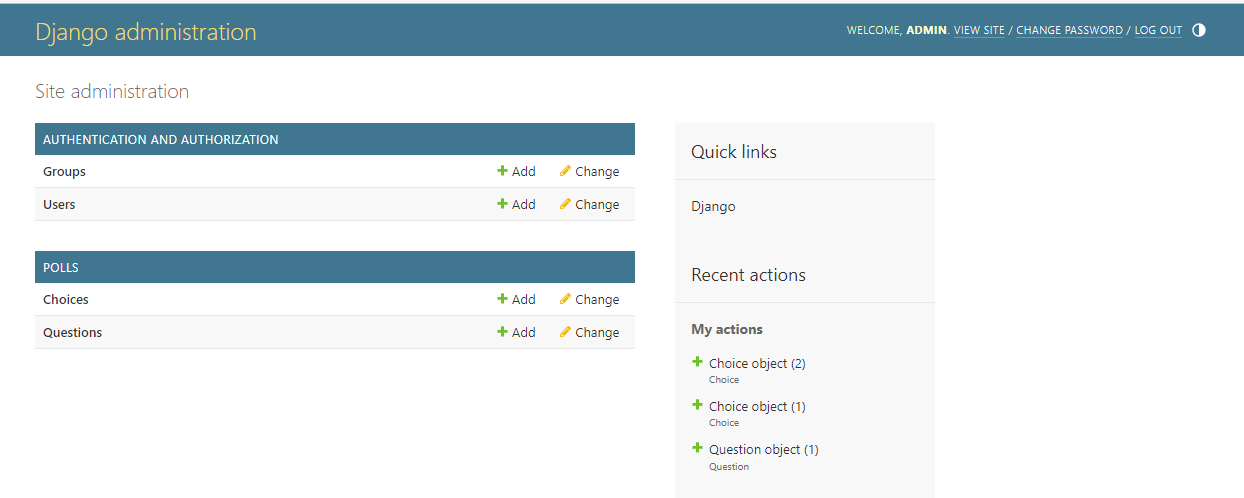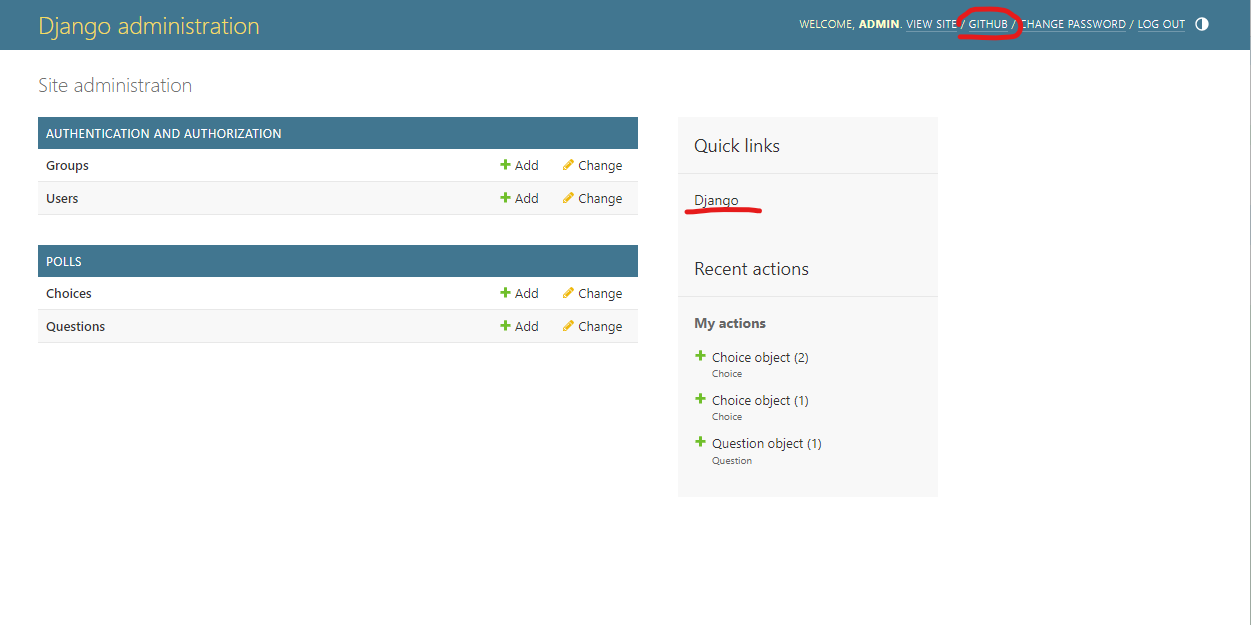Allow applications to register links in the admin interface
Shlomo
This would display a Quick links panel above the Recent actions panel with the links.


- links_module (default)
- navbar
admin.site.register_url("https://github.com/django", name="Github", location="navbar")

Adam Johnson
--
You received this message because you are subscribed to the Google Groups "Django developers (Contributions to Django itself)" group.
To unsubscribe from this group and stop receiving emails from it, send an email to django-develop...@googlegroups.com.
To view this discussion on the web visit https://groups.google.com/d/msgid/django-developers/c3f4359d-ea81-41e8-9187-7c0385019100n%40googlegroups.com.
natali...@gmail.com
Shlomo
- It is easier to selectively show links to users based on the request or a custom permission in a method rather than in the template.
- Currently each app would have to override the navbar userlinks section completely and add their relevant links which would not work if another third party app also overrides the same section. Unless {{ block.super }} is used. {{ block.super }} is not a great option since it would limit links to be added to only the beginning of the block (before VIEW SITE) or the end (after the color theme toggle). It is also close to impossible to set the ordering of links when using the {{ block.super }} approach.
- No Django apps will add a quick links section to the admin and expect other apps to use that apps Quick Links section. If the Quick Links section is implemented many different apps can utilize this central location to put links. (a setting can be added to disable this)
- If the app is not sure if the user wants the admin to have the link the app can have the link class available and let the user register it.
This can even use the Django permissions framework by default to determine if the user should see the link or not. Similar to how the PermissionRequiredMixin works.
You will still be able to override the template if needed the same way as before.
I definitely hear that having modifiers using strings can be error prone and won't scale well but this can be changed to use ENUMS instead.
menu_order = 5
on_click = None
permission_required = ["polls.view_choice", "polls.change_choice"]
url = "https://djangoproject.com"
location = admin.Location.QUICK_LINKS
def get_location(self, request):
return self.location
def get_menu_order(self,request):
return self.menu_order
def get_on_click(self,request):
return self.on_click
def will_display(self,request):
if request.user.has_perms(self.permission_required):
return True
return False
def get_url(self,request):
return self.url
def get_target(self, request):
return self.target
def get_name(self, request):
return self.name
def to_html(self,request):
return f'<a href="{self.get_url(request)}" target="{self.get_target(request)}" onClick="{self.get_on_click(request)}">{self.get_name(request)}</a>'
admin.site.register_url(RegisterDjango)
Most apps will likely add additional links to the Quick Links section, so they won't need to be wrapped. This will also cause the navbar not to have so many links. If needed there can be a max links setting that can limit the number of additional links in the navbar.
As far as link ordering I think that using an approach similar to wagtail would be the best option. In the class add a menu_order which will take a number 1 to 999. The lower the number the earlier in the list it will show up.
Mariusz Felisiak
Mariusz
Matthew Pava
I reviewed some of the history of this ticket. I tend to agree with the criticisms of adding something akin to an AdminURL to the Django admin.
However, the idea of custom views to apps in the admin is an idea that I find appealing. The history of this ticket features a comment from Tim Graham pointing us back to this ticket:
https://code.djangoproject.com/ticket/18665?cversion=1&cnum_hist=3#comment:3
Allowing registering custom admin views with the admin’s index
It was opened 11 years ago and last modified 6 years ago. This points us to an external package.
https://github.com/koleror/django-admin-views
It looks like it already has URLs implemented in the Django admin interface, so it appears that the volunteer is performing duplicate work. The last update for that project was last year.
Our fellows should probably review both tickets to determine if they should be closed.
It does appear that Julien Phalip and Jacob Kaplan-Moss both wanted the features of Django-admin-views inside the admin app. That might be a conversation worth having.
To change the text of the link you add a name parameter
from django.contrib import admin
admin.site.register_url("https://djangoproject.com", name="Django")
# or
admin.site.register_url("https://djangoproject.com", "Django")
To specify the location to add this url you add the a location parameter. This will allow any string value so that third parties can add override the template and add additional locations for the url.
Currently the url locations are:
- links_module (default)
- navbar
from django.contrib import admin
admin.site.register_url("https://djangoproject.com", name="Django")
admin.site.register_url("https://github.com/django", name="Github", location="navbar")
I am looking for feedback to solidify the design of this new feature.
--
You received this message because you are subscribed to the Google Groups "Django developers (Contributions to Django itself)" group.
To unsubscribe from this group and stop receiving emails from it, send an email to django-develop...@googlegroups.com.
To view this discussion on the web visit https://groups.google.com/d/msgid/django-developers/c3f4359d-ea81-41e8-9187-7c0385019100n%40googlegroups.com.
--
You received this message because you are subscribed to the Google Groups "Django developers (Contributions to Django itself)" group.
To unsubscribe from this group and stop receiving emails from it, send an email to
django-develop...@googlegroups.com.
To view this discussion on the web visit https://groups.google.com/d/msgid/django-developers/e541dbab-e81a-4287-afc0-8204d653dcb5n%40googlegroups.com.



